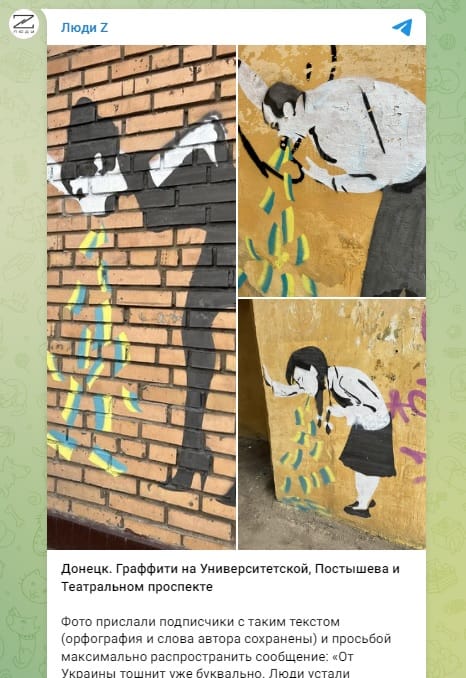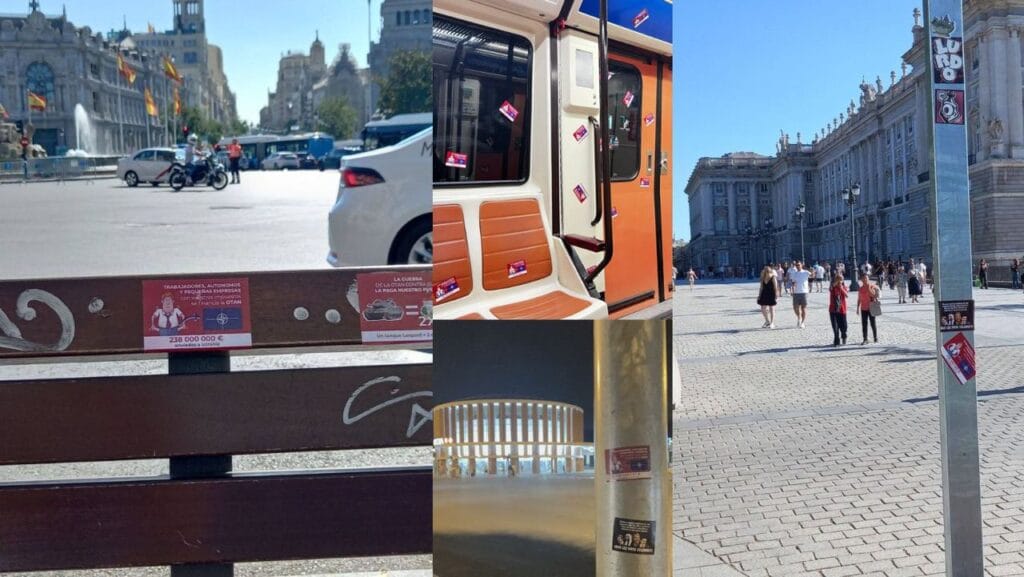At the beginning of July 2023, messages spread on Telegram about anti-Ukrainian stickers posted in the capitals of Austria and Spain. We checked whether these images were actually posted in public places in two cities.
July 3 Telegram channel “Ukraina.ru” published video (89,000 views as of this writing) with stickers depicting a man and woman vomiting Ukrainian flags. The stickers were said to have appeared in the center of Vienna, with the words "Wir haben es satt" ("We're fed up") placed next to them. July 4th Telegram channel Mash posted video (817,000 views), which showed another similar sticker allegedly placed in Vienna, depicting a girl, as well as pictures of several stickers with the text “La guerra de la OTAN contra Rusia la paga nuestro pueblo” (“NATO’s war against Russia is paid for by our people”), allegedly placed in Madrid (it is specified that there are several hundred of them in total). According to Mash, this is how the organizers of the protests called on them to “come to their senses and stop sponsoring Ukraine.” Other Telegram channels also spoke about anti-Ukrainian stickers in the capitals of Vienna and Madrid, including “Putin on Telegram"(208,000), Voblya (161,000), "Sheikh Tamir" (134,000) and "Moscow 24"(132,000 views). Co link on Mash and Ukrainu.ru» plot hit and in a row Media, blogs and social networks, becoming popular in Facebook, "VKontakte" And "Odnoklassniki"
Vein

At the request of “Verified”, fact checkers from the Austrian news agency APA identified locations included in the video. It turned out that the image of the man allegedly appeared on the window of the Facultas bookstore in Stephansplatz, women - in the MCM store window on Michaelerplatz, and the girls are at the tram stop on Schwarzenbergplatz. Our colleagues contacted the owners of retail outlets and the municipal transport company Wiener Linien. Their representatives confirmed that they discovered these anti-Ukrainian stickers on July 3, and denied their involvement in their appearance (the MCM store also did this publicly in a comment on the publication of the local Ukrainian community Mrija, indignant stickers). Soon the stickers were erased - who posted them is still unknown.
Facultas and MCM also said they filed a complaint with Vienna police about property damage and vandalism. Representatives of the department told APA journalists that they are aware of anti-Ukrainian stickers placed in the very center of the city. The police refused to comment on whether an investigation was underway and whether the organizers of the action were found.
The stickers themselves exactly repeat the three graffiti, appeared in Donetsk in August 2022. In particular, their images published Telegram channel “People Z”, noting that administrators are ready to provide mock-ups of drawings for distribution in Europe. Considering that photographs of graffiti were posted in several sources at once, and the photographs themselves were taken from different angles, we can exclude the use of photo editors and draw a conclusion about the reality of the appearance of such street art in Donetsk.

Madrid

The fact that stickers from the video published by Mash were actually posted in Madrid, July 8 reported Spanish far-right portal ÑTV España. The author of the publication claims that the stickers appeared in Puerta del Sol, Gran Via, as well as in playgrounds, schools, train stations, commuter trains and the metro, as well as on the heavily guarded Bailen street, opposite the Royal Palace in Madrid.” At the same time, the Spanish publication reported about the stickers four days later than Mash, and some of the pictures are identical to frames from the video of the Russian Telegram channel.
Existence of stickers confirms and the newspaper El Confidencial, which also published its own photographs of the stickers. The publication draws attention to the fact that the materials posted on Spanish streets contain manipulative statements, but there is no symbolism of any party or organization that staged the action. As with the Vienna stickers, it is unknown who posted the stickers; photos and other messages about stickers widely circulated in Spanish media and social networks didn't receive.
Although stickers did appear in the capitals of Austria and Spain, there is no reason to believe that their content reflects the prevailing real sentiments of residents of these countries regarding the Russian invasion of Ukraine. According to the latest data According to the European Bureau of Statistics (Eurostat), 82% of Austrians support the provision of humanitarian assistance to those affected by the war, 73% support the reception of refugees, 58% support financial support for Kyiv. In Spain, these numbers are even higher, and 60% of residents approve of the purchase and transfer of weapons to Ukraine.
Judging by the fact that information about stickers in Vienna and Madrid first appeared in Russian sources and received very little coverage in the Austrian and Spanish press, as well as foreign social networks, it can be assumed that the actions were aimed largely at a Russian-speaking audience.
Cover photo: screenshot by Mash / El Confidencial
Is it true
- APA. Sticker gegen Ukraine-Unterstützung in Wien verteilt
- Is it true that graffiti of Zelensky being hanged was painted in The Hague?
- Is it true that Russophobic stickers were posted in Auschwitz?
If you find a spelling or grammatical error, please let us know by highlighting the error text and clicking Ctrl+Enter.






